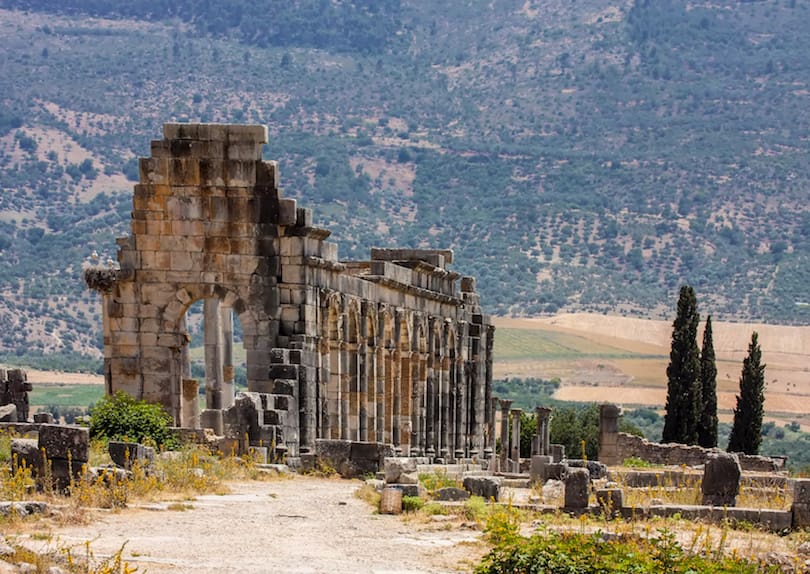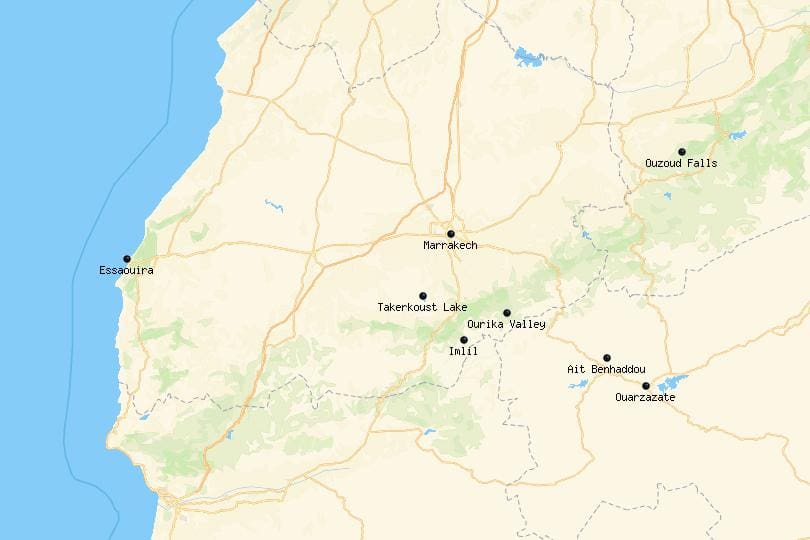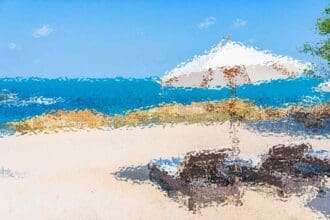Nestled in the rolling hills of northern Morocco, (Roman ruins of Volubilis in Morocco) the ancient Roman ruins of Volubilis stand as a testament to the grandeur and sophistication of one of history’s greatest empires. This UNESCO World Heritage Site offers a captivating glimpse into the past, where Roman engineering, artistry, and culture once flourished in North Africa. Whether you’re a history enthusiast, an architecture lover, or simply a curious traveler, Volubilis promises an unforgettable journey through time.
In this comprehensive guide, we’ll explore everything you need to know about visiting Volubilis, from its fascinating history and architectural highlights to practical travel tips and nearby attractions.
Overview of Volubilis
Location and Setting
- Location : Volubilis is located near the city of Meknes in northern Morocco, approximately 30 kilometers (19 miles) from the imperial city.
- Setting : Perched on a fertile plain surrounded by olive groves and the scenic Zerhoun Mountains, Volubilis enjoys a picturesque setting that adds to its charm. The site overlooks vast agricultural fields, offering panoramic views of the countryside.
Historical Significance
Volubilis was founded in the 3rd century BCE by the indigenous Berber tribes and later became a thriving Roman settlement during the 1st century CE. It served as the administrative center of the Roman province of Mauretania Tingitana and was a hub for trade, agriculture, and culture. The city thrived until the 3rd century CE when it began to decline due to political instability and shifting trade routes. Despite its eventual abandonment, Volubilis remains one of the best-preserved Roman archaeological sites in Africa.
Why Visit Volubilis?
1. A Window into Ancient Rome
Volubilis provides a unique opportunity to explore Roman life in North Africa. Its well-preserved ruins showcase the architectural brilliance and urban planning of the Roman Empire, offering insights into daily life, governance, and commerce. From public baths to triumphal arches, every structure tells a story of a civilization that once dominated the region.
2. Stunning Mosaics
The site is renowned for its exquisite mosaics, which adorn the floors of former villas and public buildings. These intricate artworks depict mythological scenes, geometric patterns, and everyday activities, reflecting the wealth and sophistication of Volubilis’ inhabitants. The mosaics are remarkably well-preserved, making them some of the finest examples of Roman artistry in the world.
3. UNESCO World Heritage Status
Designated a UNESCO World Heritage Site in 1997, Volubilis is recognized for its historical importance and exceptional preservation. It stands as a bridge between Roman, Berber, and Islamic cultures, highlighting Morocco’s rich multicultural heritage. The site serves as a reminder of the interconnectedness of civilizations across continents.
4. Scenic Beauty
Beyond its historical significance, Volubilis offers breathtaking views of the surrounding countryside. The juxtaposition of ancient ruins against the backdrop of lush greenery and distant mountains creates a serene and inspiring atmosphere. Visitors can enjoy peaceful walks amidst the remnants of a once-thriving metropolis.
History of Volubilis
Early Beginnings
Volubilis was originally a Carthaginian settlement before being incorporated into the Roman Empire under Emperor Claudius in 42 CE. Its strategic location made it a vital link in the empire’s trade network, connecting the Mediterranean world with sub-Saharan Africa. The fertile plains surrounding the city were ideal for agriculture, particularly the cultivation of olives and grains.
Roman Prosperity
During the height of Roman rule, Volubilis prospered as a center of agriculture, industry, and culture. The city featured impressive infrastructure, including aqueducts, temples, basilicas, and triumphal arches, reflecting its status as a prosperous provincial capital. Wealthy citizens built lavish villas adorned with intricate mosaics, while public spaces like forums and theaters fostered community engagement.
Decline and Rediscovery
After the fall of the Roman Empire, Volubilis gradually declined and was eventually abandoned. Over the centuries, earthquakes and looting further damaged the site. However, systematic excavations beginning in the early 20th century revealed its hidden treasures, bringing Volubilis back to life for modern visitors. Today, ongoing conservation efforts ensure that future generations can continue to appreciate this remarkable piece of history.
Must-See Highlights at Volubilis
1. The Triumphal Arch of Caracalla
Built in 217 CE in honor of Emperor Caracalla, this monumental arch marks the entrance to the city. Though partially reconstructed, it remains an iconic symbol of Volubilis’ Roman heritage. The arch features ornate carvings and inscriptions that celebrate the emperor’s contributions to the city.
2. House of Orpheus
This luxurious villa is famous for its stunning mosaics depicting Orpheus charming animals with his lyre. Other notable mosaics include scenes of Bacchus, the god of wine, and marine motifs. The House of Orpheus provides a glimpse into the opulent lifestyle of Volubilis’ elite residents.
3. Capitol Temple
Dedicated to the Roman triad of Jupiter, Juno, and Minerva, the Capitol Temple dominates the skyline of Volubilis. Its elevated position underscores its importance as a religious and civic center. The temple’s grand columns and sweeping steps evoke the majesty of Roman architecture.
4. Decumanus Maximus
The main street of Volubilis, lined with columns and flanked by shops and residences, provides a vivid picture of the city’s bustling commercial life. Walking along this ancient thoroughfare feels like stepping back in time. Look out for remnants of olive presses and other industrial facilities along the way.
5. Basilica and Forum
Once the heart of public life in Volubilis, the basilica housed legal proceedings and civic functions. Adjacent to it lies the forum, a large open space where citizens gathered for markets, speeches, and social events. These structures highlight the importance of civic engagement in Roman society.
6. Thermal Baths
The Roman love for bathing is evident in the well-preserved thermal baths, complete with heated floors and water channels. These facilities highlight the advanced engineering skills of the Romans and their commitment to hygiene and leisure.
7. Olive Presses
As a major producer of olive oil, Volubilis features several ancient olive presses. These remnants of industrial activity underscore the city’s economic significance. Olive oil was not only a staple of Roman cuisine but also a valuable commodity traded throughout the empire.
Best Time to Visit – Roman ruins of Volubilis in Morocco
The ideal time to visit Volubilis is during the spring (March to May) or autumn (September to November) when the weather is mild and pleasant. Summers can be hot, while winters may bring occasional rain.
- Spring : Blooming wildflowers add vibrant colors to the landscape, creating a picturesque setting for photography.
- Autumn : Cooler temperatures make exploring the ruins more comfortable, especially during midday.
- Avoid Peak Midday Heat : Plan your visit early in the morning or late afternoon to avoid the sun’s intensity. The soft lighting during these times also enhances the beauty of the ruins.
How to Get There
By Car
- From Meknes , take the N13 highway towards Moulay Idriss. Volubilis is clearly signposted along the route.
- The drive takes approximately 45 minutes and offers scenic views of the countryside. Renting a car gives you the flexibility to explore nearby attractions at your own pace.
By Taxi
- Hire a grand taxi from Meknes or Moulay Idriss. Negotiate the fare beforehand, as taxis are not metered. Shared taxis are cheaper but may require waiting for other passengers.
Guided Tours
- Many tour operators in Fez, Meknes, or Rabat offer day trips to Volubilis, often combined with visits to Moulay Idriss and Meknes. This option is convenient for those seeking hassle-free transportation and expert commentary. Tours typically include round-trip transport, entrance fees, and guided tours of the site.
Practical Travel Tips
1. Entrance Fees
- Admission to Volubilis costs approximately 20 MAD (Moroccan Dirhams) for adults. Discounts may apply for students and children. Bring cash, as card payments are not accepted.
2. Guided Tours
- Hiring a local guide is highly recommended to gain deeper insights into the history and significance of the ruins. Guides are available at the entrance or can be arranged through your hotel or tour operator. Their expertise brings the site to life, providing context and stories behind each structure.
3. What to Bring
- Comfortable walking shoes for exploring the uneven terrain.
- Sunscreen, hat, and sunglasses to protect against the sun.
- Water bottles to stay hydrated, as there are limited refreshment options onsite.
- A camera or smartphone to capture the intricate details of the mosaics and panoramic views.
4. Photography
- Photography is allowed throughout the site. Capture the intricate mosaics and panoramic views of the ruins against the Zerhoun Mountains. Early mornings and late afternoons provide the best lighting for photography.
5. Respect the Site
- Do not touch or step on the mosaics, as they are fragile and irreplaceable.
- Follow designated paths to preserve the integrity of the ruins.
- Dispose of trash responsibly to maintain the site’s cleanliness.
Nearby Attractions
1. Moulay Idriss
Just a few kilometers from Volubilis lies the holy town of Moulay Idriss, named after the founder of Morocco’s first Islamic dynasty. Its whitewashed houses and green-tiled roofs create a striking contrast against the hills. The town is a pilgrimage site and offers stunning views of the surrounding landscape.
2. Meknes
A short drive away, Meknes is one of Morocco’s four imperial cities. Explore its historic medina, Bab Mansour gate, and the sprawling granaries and stables of Sultan Moulay Ismail. Meknes combines Roman, Islamic, and Moroccan influences, making it a fascinating destination.
3. Fez
For a deeper dive into Moroccan history, visit Fez, home to the world’s oldest university and a labyrinthine medina brimming with artisan workshops and cultural landmarks. Fez is a must-visit for anyone interested in Islamic architecture and traditional crafts.
Conclusion
The Roman ruins of Volubilis are a treasure trove of history, art, and architecture, offering a rare glimpse into Morocco’s ancient past. As you wander through its weathered stones and marvel at its intricate mosaics, you’ll feel transported to a bygone era of splendor and sophistication. Whether you’re tracing the footsteps of Roman citizens, admiring the craftsmanship of master artisans, or soaking in the natural beauty of the region, Volubilis promises an enriching and memorable experience.
Plan your visit today and uncover the timeless allure of this extraordinary archaeological wonder!
Frequently Asked Questions (FAQs) – Roman ruins of Volubilis in Morocco
- How long does it take to explore Volubilis?
- A typical visit lasts 1.5 to 2 hours, but history enthusiasts may spend longer exploring the details.
- Is Volubilis wheelchair accessible?
- Some areas are accessible, but much of the site involves uneven terrain and steps. Wheelchair users may face challenges navigating certain sections.
- Are there guided tours available?
- Yes, licensed guides are available at the entrance or can be arranged in advance. Guided tours enhance the experience by providing historical context and interesting anecdotes.
- Can I visit Volubilis independently?
- Yes, independent visits are possible, but hiring a guide enhances the experience. Self-guided exploration allows for flexibility but may lack depth without prior knowledge.
- What should I wear?
- Wear comfortable clothing and sturdy shoes suitable for walking on uneven surfaces. Layers are advisable, as temperatures can vary throughout the day.
- Are pets allowed?
- Pets are generally not permitted within the archaeological site to protect the ruins and ensure visitor safety.
- Is food available onsite?
- No, so bring snacks and water for your visit. There are no restaurants or cafes within the site, though vendors may sell refreshments near the entrance.
- What other sites pair well with Volubilis?
- Moulay Idriss and Meknes are popular additions to a day trip itinerary. Both destinations complement Volubilis with their historical and cultural significance.
- Do I need special permits to photograph the ruins?
- No permits are required for personal photography, but drones are prohibited to preserve the site’s integrity.
- Is Volubilis safe for solo travelers?
- Yes, it is safe and welcoming for all types of travelers. However, always exercise caution and follow basic safety precautions.






